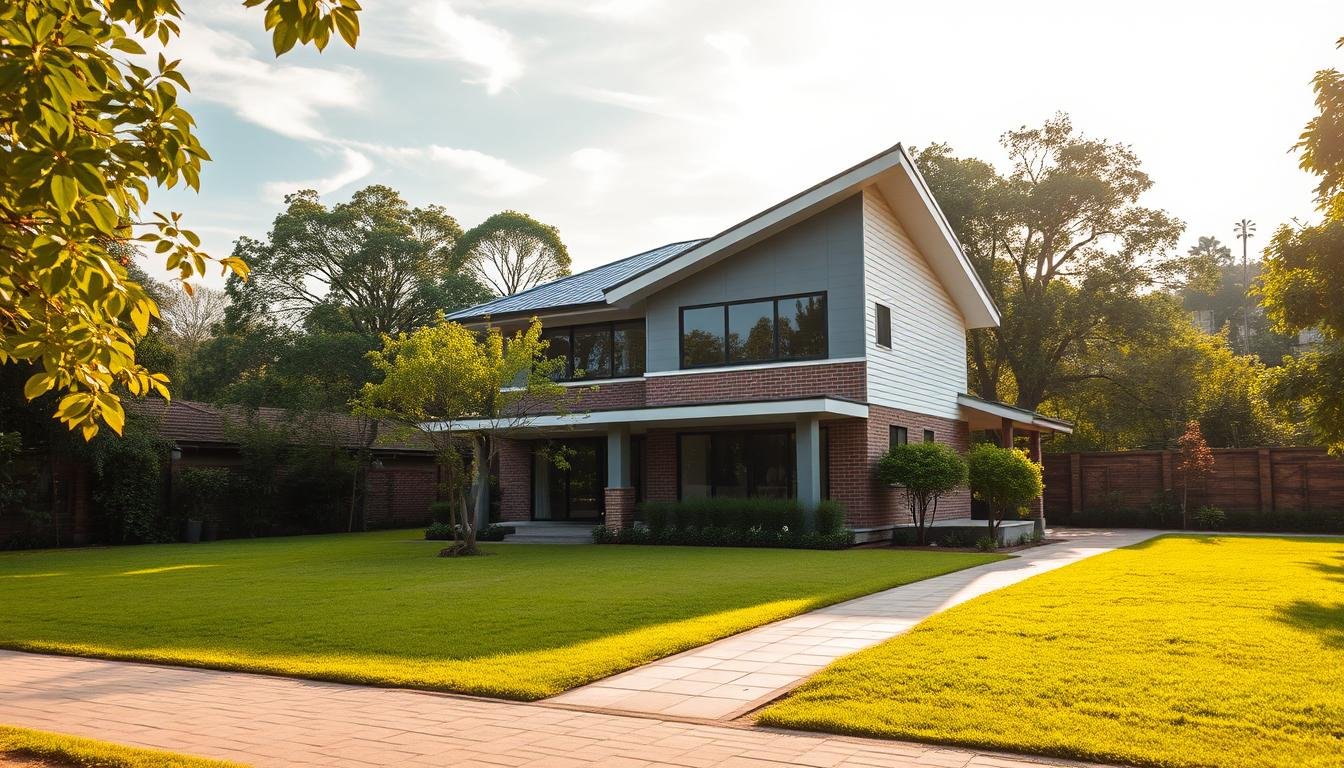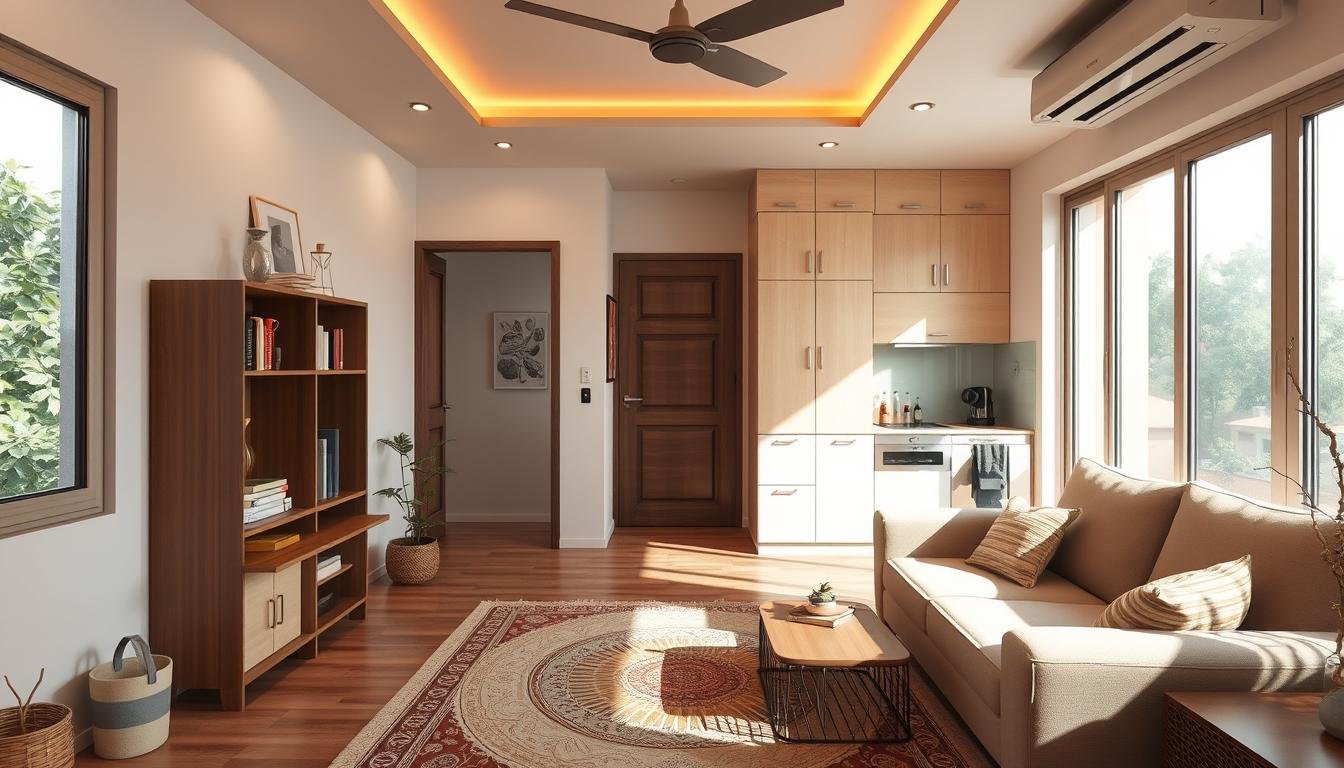Can small changes and smart sourcing make your house look like a curated Indian home without hiring an architect?
We think so. In this guide we set clear, budget-friendly moves that blend classic interior design cues — vibrant colors, carved wood, jaalis and folk art — with quick weekend projects.
Our plan focuses on high-impact levers: textiles, lighting, small carpentry and curated décor. These choices give a cohesive look and work in rentals and owned homes alike.
We will favor teak and sheesham, handcrafted brass and pottery, ikat and khadi fabrics, plus simple tricks like gallery walls, patchwork accents and ladder plant stands. Each idea aims to be doable with local materials and simple tools so we save on fees and avoid major work.
Budget-Savvy Strategy: How We Plan DIY Interiors in India Without an Architect
With layered textures and phased buys, we make thoughtful interiors that feel polished and personal. We favor gallery walls, contrast with pastels plus pops, and highlight travel souvenirs and family photos to add character when a designer isn’t on hand.
Our approach keeps costs low and results consistent across rooms. We start by setting a clear scope: pick priority rooms, list three to five design ideas per room, and measure each space carefully. Knowing windows, switches, and door swings prevents costly clashes later.
- Define a style baseline: shared palette, wood tones, and fabric families so all rooms read as one interior.
- Phase purchases: soft furnishings first, lighting next, then accent furniture to manage cash flow.
- Use reversible fixes—peel-and-stick, tension rods, loose rugs—so renters can personalize without damage.
- Document costs, sources, and lead times; hire local carpenters only for high-ROI pieces like a compact pooja shelf or shoe cabinet.
- Keep a basic tool kit and a weekend routine: one project at a time, with planned clean-up to keep the house livable.
We keep an inspiration board and follow a one-in, one-out rule to avoid clutter. This way we transform small spaces into layered, livable homes that reflect personal style without breaking the budget.
Color First: Vibrant Indian Palettes That Transform Rooms on a Budget
Smart use of earthy hues and bright accents transforms a space on a tight budget. We start with warm bases and add small bursts so the result feels intentional and lived-in.

Earthy bases with pops: ochre, terracotta, burnt orange
We ground a room in ochre, terracotta, or burnt orange to add warmth and reduce repaint frequency. These bases pair well with wood floors and bronze hardware.
Accent bursts on soft furnishings and art
Brighter yellows, pinks, blues and greens work best as cushions, throws, or a chair. Small swaps refresh the look seasonally without repainting walls.
Two-tone schemes that reduce repaint costs
Use a neutral main wall and a deeper shade on a single feature wall to balance energy and calm. Test paint on poster boards at different times to check undertones.
- Coordinate drapes and rugs with base shades to tie open spaces together.
- Introduce small metallic accents like brass to complement warm colour stories.
| Base Shade | Accent | Best Application |
|---|---|---|
| Ochre yellow | Indigo cushions | Living room feature wall |
| Terracotta | Teal throw | Dining chair upholstery |
| Burnt orange | Mustard pillows | Entry rug and art |
| Neutral beige | Primary color pops | Two-tone walls for calm + energy |
These colour choices fit our interior goals and make small rooms feel curated. They also keep repaint costs down while giving the home a cohesive look and style.
Solid Wood and Desi Details: Affordable Ways to Get the Indian Interior Look
A few solid-wood anchors and a single ornate focal piece lift a room’s look quickly and affordably. We favor robust timber and subtle brass to give rooms a lived, curated feel without major expense.
Choosing teak, sheesham, or reclaimed wood wisely
We prioritise teak and sheesham for long-life furniture that withstands humid climates. These woods offer grain and strength that age well.
When budget or character matters, we hunt reclaimed wood for consoles and benches. Reclaimed pieces add patina and reduce waste.
Upcycling chests, jharokhas, and birdcages as focal pieces
One ornate chest or mounted jharokha becomes an instant focal point. We upcycle chests into coffee tables with storage to fit compact spaces.
- Inspect joinery, grain, and seasoning to avoid warping or termites.
- Mix cane seats for breathable seating and lighter silhouettes in small homes.
- Suspend small birdcages as lanterns or planters and add brass bells for layered décor.
- Choose one ornate centerpiece and keep surrounding furniture simple to prevent clutter.
- Oil or wax finishes regularly to protect the wood and highlight natural grain.
Inlays, Carvings, and Jaalis: Small Touches, Big Design Impact
A few well-placed inlays and jaali panels can change how a room reads and how light moves through it. We focus on modest alterations that add craft and function without heavy work.
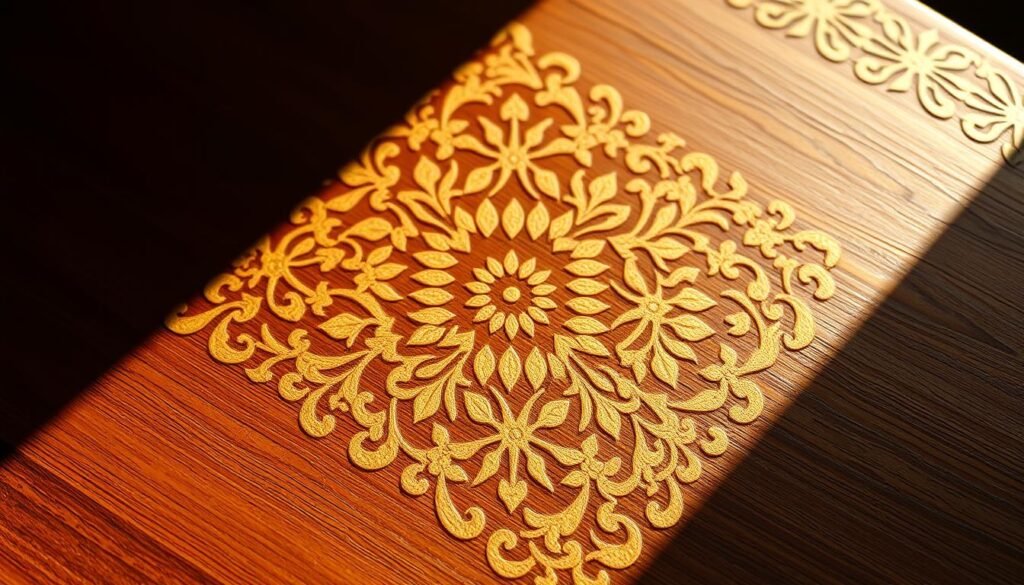
Traditional cabinets often feature mirror, stone, ivory, or metal inlays. We revive tired storage with stick-on mirror or thin metal strips to mimic heirloom detail at a fraction of the cost.
Jaalis work as partitions, shutters, wall panels, furniture inserts, and even ceiling features. We frame MDF or plywood panels for lightweight partitions that let daylight travel while zoning spaces.
- Choose laser-cut PVC for humid zones and wood/MDF for dry indoor areas.
- Retrofit jaali shutters on pooja units or kitchen entrances for ventilation and visual interest.
- Test panel density to balance privacy with airflow; pick patterns that echo the room’s overall style.
- Mount a shallow jaali on the ceiling as a tray with concealed LEDs for soft ambience.
- Seal inlays and carvings with clear coats in high-traffic areas to prevent scuffs and stains.
| Element | Material | Best Use | Maintenance |
|---|---|---|---|
| Mirror inlay strips | Adhesive mirror/metal | Cabinet faces, small chests | Wipe with soft cloth; avoid abrasives |
| Jaali panel | Laser-cut PVC / MDF | Partitions, wall panels, ceiling tray | Vacuum gently; seal edges in kitchens |
| Carved brackets | Teak / Sheesham / Resin | Under shelves, altar ledges | Oil wood; touch up resin paint |
| Metal inlay accents | Brass / Tin strips | Drawer fronts, trim details | Polish occasionally; clear coat for protection |
We pair ornate inlays with plain wood pieces nearby. This keeps the room harmonious and avoids an overly ornate feel. Plan locations to reduce dust traps and ensure cleaning access.
Living Room Comfort: Informal Seating and Swings for Family Time
A relaxed living area encourages conversation when seating is layered and intentionally informal. We favour varied levels so everyone can gather without fuss.
Layered seating with rugs, floor cushions, and a jhoola
We anchor the living room with a dhurrie or flatweave rug, then add gaddas and floor cushions for flexible seating. A low divan plus armless chairs keep sightlines open in smaller rooms.
Adding a compact jhoola creates a playful focal point. Install it only after confirming ceiling reinforcement and using rated hardware with the correct load capacity.
- Choose washable covers for cushions and throws to lower maintenance in high-traffic zones.
- Add nested side tables for serving without crowding the floor area.
- Use dimmable floor lamps and warm LEDs to set a cosy evening ambience.
- Keep one wall free for a simple media unit and hide cables to reduce visual noise.
- Map furniture footprints with masking tape before buying to confirm clearances.
We echo upholstery colours with art and planters so the living area feels curated. Pick one conversation piece—such as a carved swing back or a patterned rug—to define the room’s style and knit the interior together.
Curios, Pottery, and Brass: Styling Nooks the Indian Way
Curating small curios can turn an overlooked corner into a soulful, functional vignette.
We favour masks, clay pottery, diyas, leather puppets, and brass lamps to anchor a niche. A Jaipur blue pottery vase pairs well with a carved sandalwood or marble box to show craft lineage.
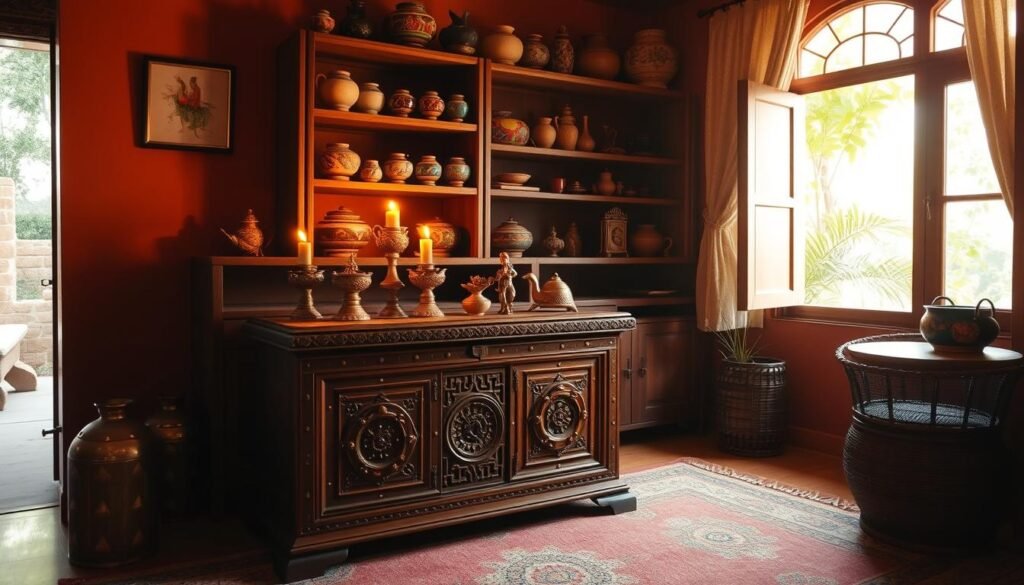
Vary heights with books or low pedestals so items read as a styled group, not a lineup. Add a leafy plant for freshness and to soften brass and terracotta tones.
- Check mirrors and vases for authenticity marks—base stamps or aged mercury spots—to avoid overpriced replicas.
- Coordinate metal finishes; limit tones so small spaces stay calm.
- Repeat a motif—lotus, peacock, or paisley—across two or three pieces to create visual rhythm.
Rotate artifacts seasonally and leave negative space so each object can breathe. Mount a small wall shelf to elevate a prized item and log artisan sources for future buys or gifts.
Fabrics That Speak India: Ikat, Dabu, Ajrakh, and Khadi
Fabrics carry a room’s mood; the right weave and print can make a modest space feel curated and layered.
We use traditional prints and natural weaves to shift scale and colour without big interventions. Textiles work across sofas, windows, and floors. Small swaps give a fresh look quickly and keep the base pieces neutral so seasonal changes feel simple.
Quick swaps: cushion covers, dhurries, and throws
We refresh seating by replacing cushion covers and adding ikat, dabu, or ajrakh throws. Dhurries bring washable colour underfoot and suit humid climates.
Low-cost window drama with long drapes
Ceiling-height drapes lengthen sightlines and make windows read taller. Use cotton or khadi panels for breathability and an artisanal look.
Patchwork accents as wall art or tapestries
Framed patchwork makes an instant statement without paint. Jute stools and cotton upholstery balance bold prints and add texture.
- Mix small and large prints in one colour family to avoid visual noise.
- Launder removable covers regularly to keep colours bright and air fresh.
- Measure yardage first to prevent mismatched dye lots.
Pooja Corners and Mandirs: Wood or Marble Sanctuaries at Home
A small mandir thoughtfully sited and lit brings ritual and calm into even the tightest apartment corners. We prefer classic materials — warm wood or cool marble — so the altar reads as craft rather than clutter.
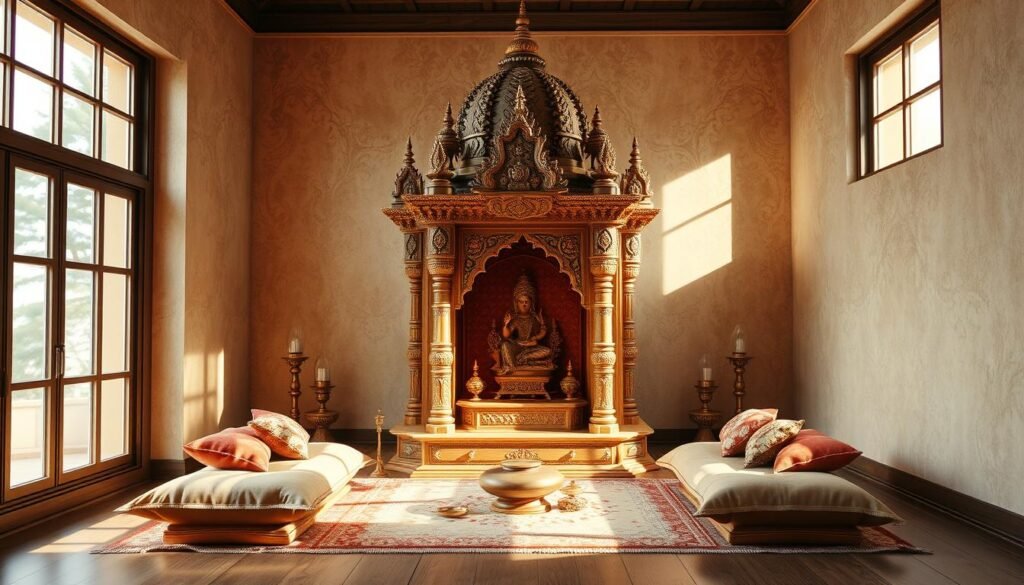
Compact altar layouts for apartments
We pick a quiet place with gentle circulation, away from heavy footfall. A narrow footprint lets a mandir fit naturally into a living room alcove or a calm bedroom corner.
For practicality, we add a slim drawer or a concealed shelf for diya oil, incense, and matches. This storage keeps the area tidy and ritual-ready.
Lighting, bells, and storage for essentials
Soft, warm under-shelf LEDs create ritual ambience without glare. We mount a tiny bell and use an LED diya for safety near fabrics and curtains.
- Back the altar with a plain or lightly patterned panel so idols remain the visual focus and art stands out.
- Choose a wipeable stone or laminate top for easy cleaning of soot and oil spills.
- Confirm ceiling clearance and ventilation when placing taller wooden units to avoid heat buildup.
- Use brass or stone holders for candles and avoid synthetic fragrances near open flames.
- Keep a microfiber cloth handy to maintain shine on brass and marble surfaces.
| Material | Feel | Maintenance |
|---|---|---|
| Teak or Sheesham | Warm, traditional style | Oil occasionally; check vents |
| Marble/Granite | Elegant, cool surface | Wipeable; resists soot |
| Laminate top over plywood | Practical, budget-friendly | Easy clean; avoid direct flame |
We align mandir finishes with the rest of the interior so the sacred corner feels integrated, not tacked on. A well-crafted altar balances ritual needs, storage, and the room’s overall décor.
Walls With a Story: Folk Art, Mandalas, and DIY Feature Finishes
Walls can become a canvas for stories that travel across regions and seasons. A single feature wall gives character without heavy work. We pick one wall per room to avoid visual overload and to make each space feel intentional.
Warli, Madhubani, or wallpaper
Folk motifs like Warli and Madhubani add regional craft and warmth. When commissioning is not possible, stencils or printed wallpaper give a similar look. Mandalas work well as a central motif to bring calm and focus to busy family areas.
Peel-and-stick patterns and oversized frames
Peel-and-stick sheets suit renters who want bold pattern with easy removal. For gallery drama, we build oversized frames from canvas and slim wood strips to elevate prints and kids’ art.
Lights, mirrors, and coordination
Placing a mirror opposite art and adding fairy lights multiplies light and creates evening mood. We coordinate motifs with fabrics so either the wall or textiles stay quiet, not both loud.
- Test wallpaper on a small patch for adhesion and residue.
- Document paint finishes and wall prep steps for clean edges.
- Choose washable paints in high-touch zones for easy cleaning.
- Add a slim picture ledge to rotate artwork without new holes.
| Approach | Material | Best Use |
|---|---|---|
| Commissioned mural | Hand paint | Feature wall in living room |
| Stencil | Acrylic paint + stencil | Accent strip or small wall |
| Peel-and-stick | Vinyl wallpaper | Renter-friendly pattern |
Balcony and Outdoor Nooks: Rustic Furniture, Greens, and Cozy Textures
We can turn tight outdoor corners into cosy nooks with a few measured choices and hardy greenery. Small balconies thrive when seating fits the space and plants add calm.
Choose folding wicker chairs or a slender bench to keep movement easy. Add printed cushions and a throw for seasonal colour and weather-resistant comfort.
Layer an outdoor-friendly rug to soften the floor and define the chill zone. Place a small side table with a tray to protect surfaces from water rings.
- Pick easy-care plants like snake plant or money plant to green the view without fuss.
- Hang vertical planters to save floor area and create a lush backdrop.
- Use solar lanterns or warm fairy lights for evening ambience without rewiring.
| Option | Best for | Floor impact | Maintenance |
|---|---|---|---|
| Folding wicker chair | Narrow balconies | Minimal; easy to move | Wipe; store in heavy rain |
| Slender wooden bench | Seating + storage | Anchors the area | Oil occasionally; cover |
| Outdoor rug | Defines nook | Softens concrete floor | Shake out; hose down |
| Vertical planters | Limited floor space | Keeps floor clear | Check drainage; rust-proof hooks |
We keep to a calm palette—greens, terracotta, and one accent colour. Simple choices protect finishes and make small spaces feel like extensions of our homes and designs.
Kids’ Rooms the Desi Way: Color, Prints, and Easy-to-Update Decor
Kids respond to color and pattern, so we build rooms that can shift with their tastes.
Start with cheerful block-printed curtains, washable rugs, and Jaipur-print sheets. These textiles set the mood and can change fast, saving us repaint time and expense.
Block-printed curtains, rugs, and changeable bedding
We keep large furniture neutral and durable so textiles lead the theme. Jute blinds or paisley wallpaper add local character while staying reversible.
- Cheerful prints for curtains and bedding let the room evolve without repainting.
- Labeled storage bins and under-bed drawers speed cleanup and improve storage.
- Cork or magnetic boards display artwork without damaging walls.
- Washable rugs, duvet covers, task lighting, and child-safe hardware keep the space practical and safe.
- Rotate themes with decals and pillowcases and add a small reading corner with a floor cushion.
| Element | Material | Benefit |
|---|---|---|
| Curtains | Block-print cotton | Bright, washable, easy to swap |
| Rug | Machine-washable flatweave | Handles spills; adds colour |
| Storage | Plastic bins / fabric drawers | Organized, labeled, quick tidy-ups |
These small moves give the room a lively interior that suits family living and growing tastes. They also align with simple home decor ideas for an indian home without built-ins.
Bathrooms With Desi Glam: Tiles, Vanities, and Smart Contrasts
Small accents—patterned tiles, a wooden vanity, a mosaic band—can turn an ordinary washroom into a soulful retreat. We focus on a few bold moves that deliver a lasting interior design impact without a full overhaul.
Hand-painted and patterned tiles for accent zones
We concentrate patterned tiles in a shower niche or behind the vanity to keep costs and maintenance low. A single bold tone paired with muted neighbors reads intentional, not chaotic.
Hand-painted motifs are widely available and work well in small doses. Glass mosaic bands make a wipeable color accent that brightens mirrors and splashbacks.
Traditional wooden vanities with storage
We like compact wooden vanities with cabriole legs and closed storage to hide toiletries and keep the look calm. Proper sealing and good ventilation protect wood finishes in humid bathrooms.
For flooring, red oxide or an oxide-look treatment gives a warm, smooth surface underfoot that suits traditional styles. Upgrade hardware to brass or matte black for a cohesive look tied to mirrors and lights.
- Focus patterned tiles on a niche or splashback to control cost and cleaning.
- Balance bold tiles withquiet field tiles for contrast that feels deliberate.
- Choose a vanity with closed storage to reduce visual clutter and increase practical storage.
- Add warm, high-CRI LEDs at the mirror for accurate grooming light.
- Seal grout and schedule simple maintenance to keep surfaces fresh and mildew-free.
| Element | Best Use | Material/Finish | Maintenance |
|---|---|---|---|
| Accent tile band | Vanity splashback / shower niche | Hand-painted ceramic / glass mosaic | Wipe; seal grout annually |
| Wooden vanity | Small bathrooms, concealed storage | Teak or sheesham, clear seal | Ventilate; oil occasionally |
| Floor | Comfort underfoot, cohesive style | Red oxide / oxide-look finish | Recoat when worn; avoid standing water |
| Finishes | Hardware & lighting | Brass or matte black fixtures | Polish brass; clean black fittings gently |
diy home design tips india: Step-by-Step Mini Projects to Save Money Now
Quick weekend projects can refresh key corners and save real money when we plan clearly.
We list fast, low-cost ideas that help create visible change without big skill or expense. Each mini project suits small spaces and busy schedules.
- Upcycle a ladder into a vertical plant stand—sand, varnish or paint, then stagger pots for a green statement.
- Cut PVC sections into a honeycomb shoe rack, drill and glue, then paint to match the entry.
- Tie glass bottles with coir rope and hang stems or money plant cuttings for a lightweight balcony feature.
- Make an oversized frame: mount a print on canvas and finish with glued wood stick rails.
- Add pom-poms or tassels to cushion edges, or wrap jars with jute for candle holders.
| Project | Time | Cost | Skill |
|---|---|---|---|
| Ladder plant shelf | 2–4 hours | Low | Beginner |
| PVC shoe rack | 2–3 hours | Low | Beginner |
| Hanging bottles | 1–2 hours | Very low | Beginner |
| Oversized frame | 2–3 hours | Low | Basic woodworking |
These projects make a quick makeover and help create cozy nooks, more storage, and fresh surfaces for our rooms and furniture.
Conclusion
A few careful moves—color, textiles, and one well-made piece—give the biggest returns on interior design ideas and budget.
Start by treating the living room and one bedroom as priority zones. Layer fabrics, add solid-wood furniture, and use art and lighting to bind the rooms into a cohesive style.
Keep storage tucked into benches, chests, and vanities so each room looks calm and functions daily. Style the balcony with plants and weatherproof textiles to extend living outdoors.
Lean on artisan pieces and jaalis to celebrate an indian home aesthetic without heavy renovation. Pace projects: one side of a room per weekend and test peel-and-stick finishes before committing.
Finish with a simple maintenance plan—washable covers, sealed wood, and plant care—to make these home decor efforts last and improve everyday life.


